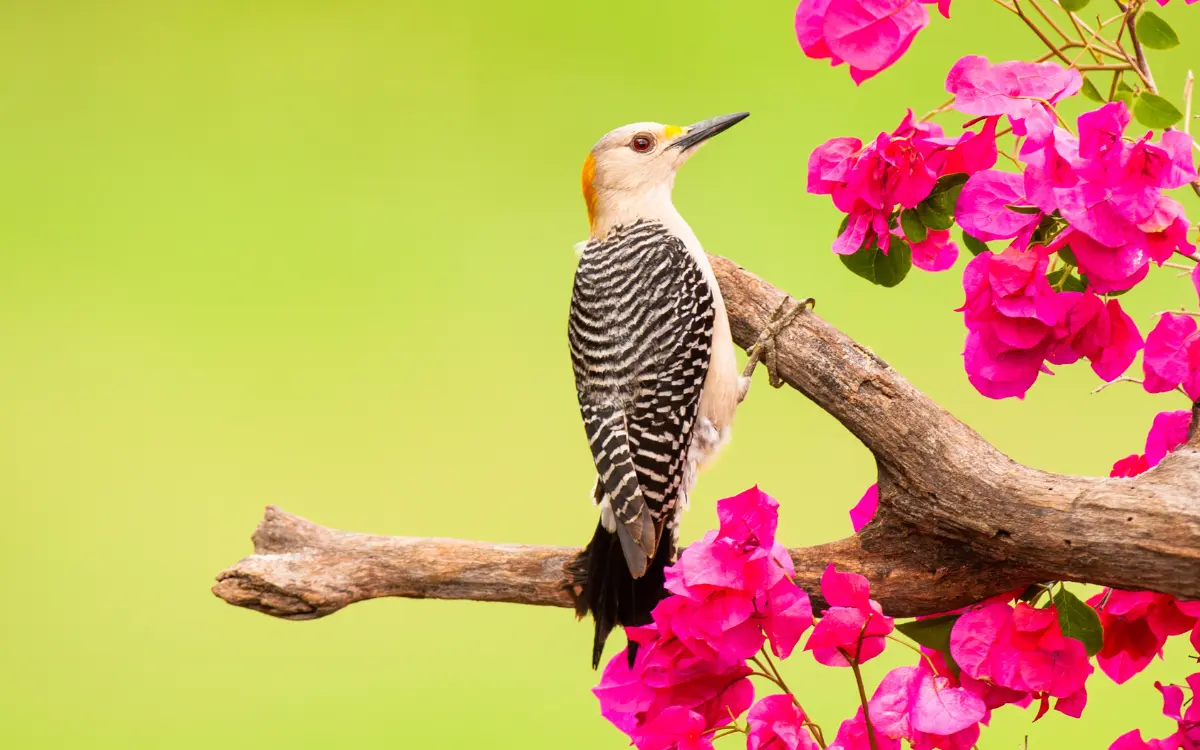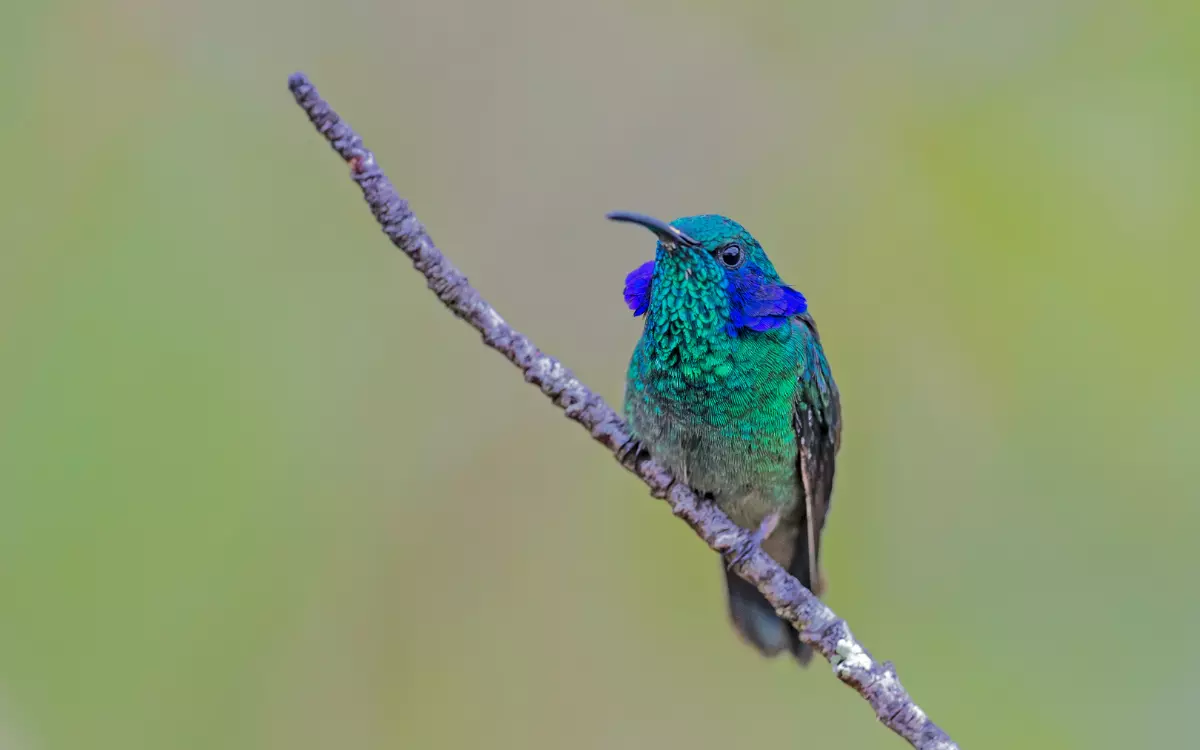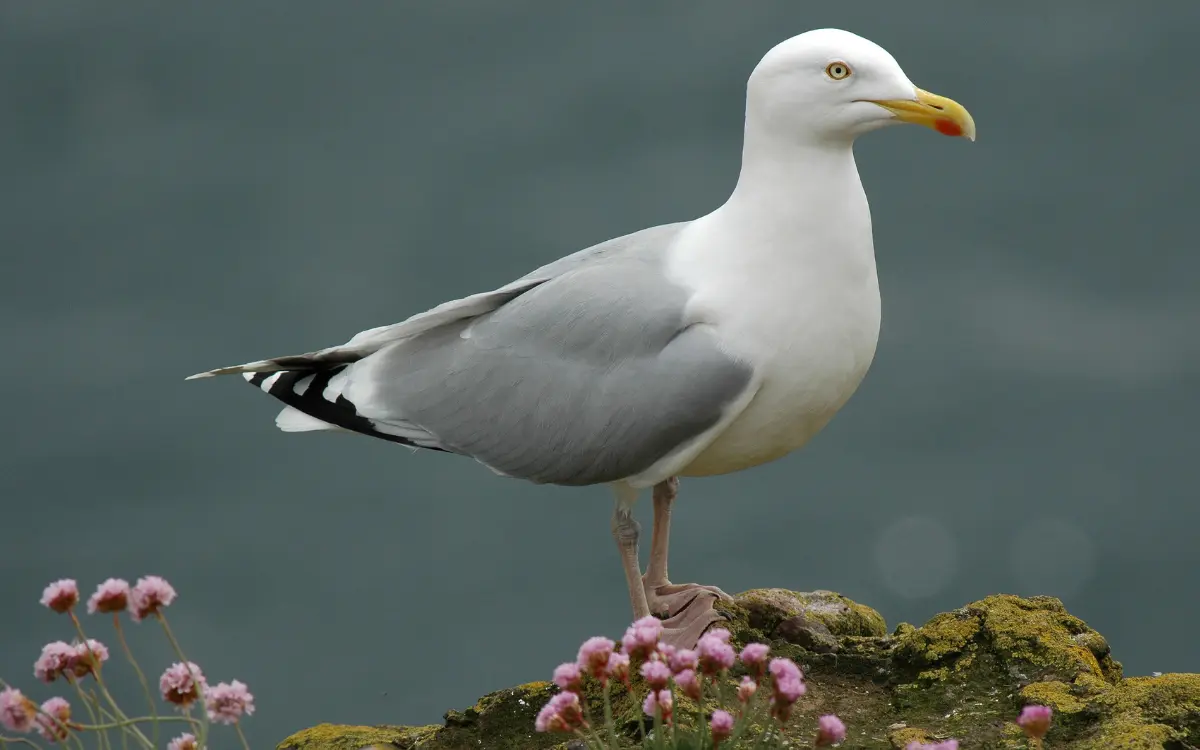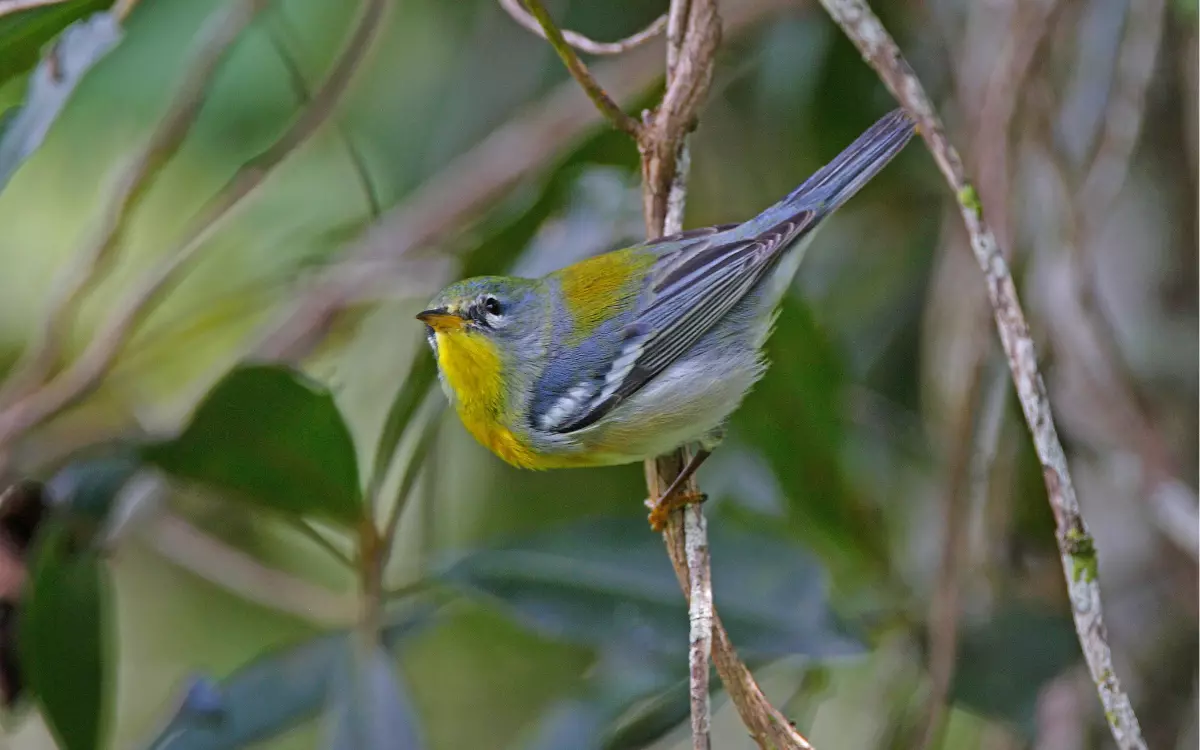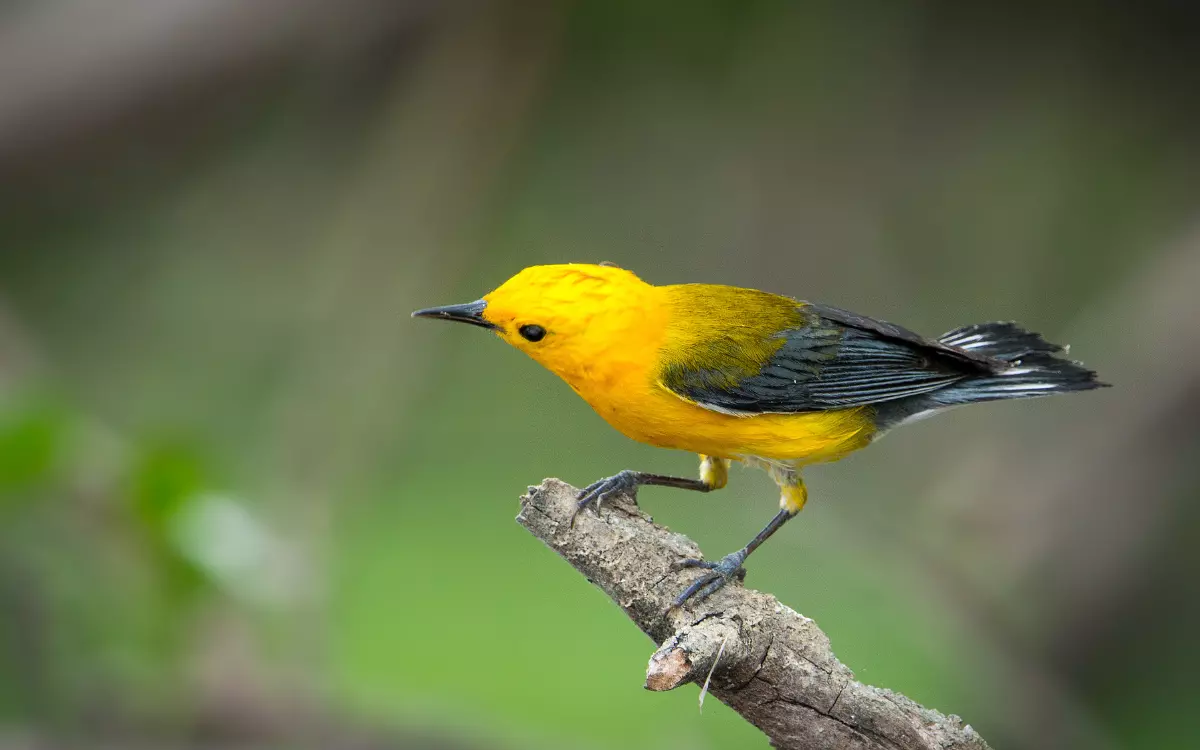Red, Orange, & Yellow Birds of Wyoming
Are you living in a Wyoming city do you love to explore the birds?
You can see various colors of birds in this list we will give you information about Red, Orange, & Yellow birds that can amaze you with their natural beauty.
The Role of Color in Bird Identification
Although color is an intriguing aspect of bird identification, it’s important to note that other factors, such as shape and size, often play a pivotal role in distinguishing one species from another. Interestingly, even a black-and-white photograph can be surprisingly effective in identifying most North American birds.
Bird Species to Watch For: Wyoming’s Colorful Residents
Here, we’ll explore some of the enchanting bird species that frequently grace Wyoming’s backyards, towns, and open spaces. While this isn’t an exhaustive list, it includes birds you’re likely to encounter during your outdoor adventures.
Red Birds of Wyoming: A Colorful Avian Marvel:
1.Summer Tanager (Piranga rubra)
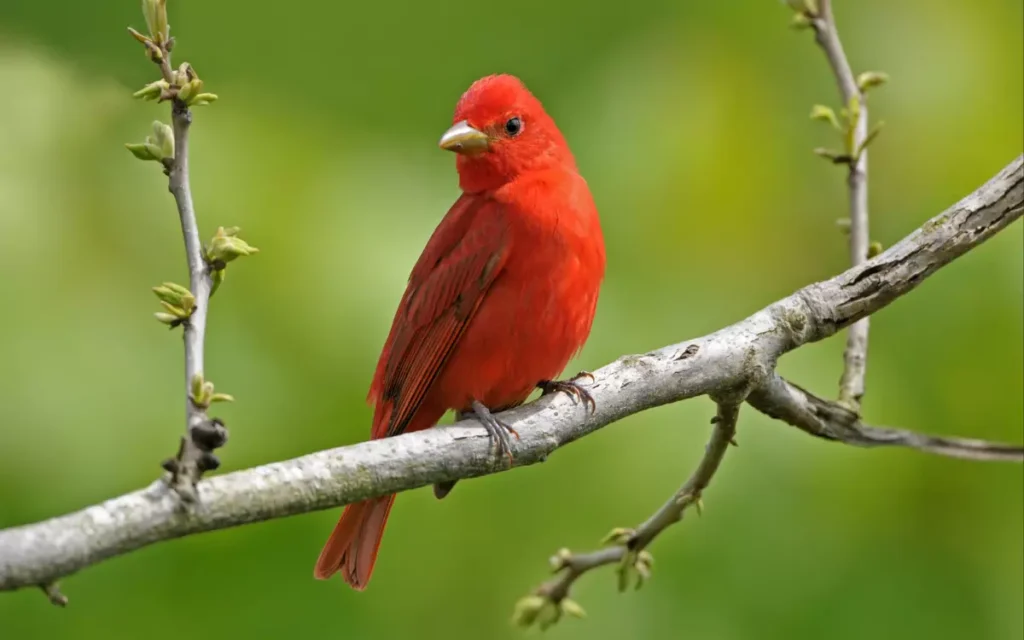
The Summer Tanager, a graceful songbird, is a true embodiment of Wyoming’s natural beauty. With its striking red plumage, it stands out against the lush greenery of its habitat.
These delightful birds are known for their vibrant melodies that fill the summer air. Interestingly, the Summer Tanager’s coloring is the result of its diet, primarily consisting of beetles, bees, and wasps, rich in carotenoids. These birds lay clutches of 2-4 eggs, creating cosy nests high in the trees.
- Length: 6.7 in (17 cm)
- Weight: 1.1 oz (30 g)
- Wingspan: 11.02 – 11.811 In (28 to 30 cm)
- Lifespan: 5 years.
Call:-
2. House Finch (Haemorhous mexicanus)
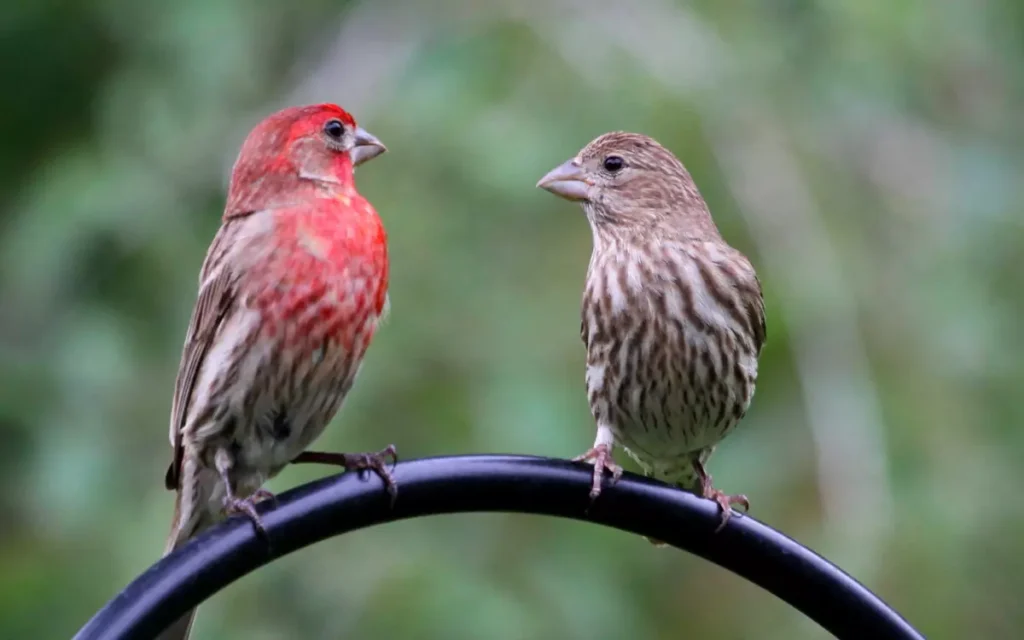
The House Finch, with its distinctive red crown, is a common sight across Wyoming. These adaptable birds have a diverse diet that ranges from seeds and fruits to insects, allowing them to thrive in various environments.
House Finches are known to lay about 2-6 eggs per clutch. Their melodious songs and charming demeanour make them a favorite among bird enthusiasts.
- Length: 5.1-5.5 in (13-14 cm)
- Weight: 0.6-0.9 oz (16-27 g)
- Wingspan: 7.9-9.8 in (20-25 cm)
- Lifespan:11 years and 7 months
CALL:-
3.Pine Grosbeak (Pinicola enucleator)
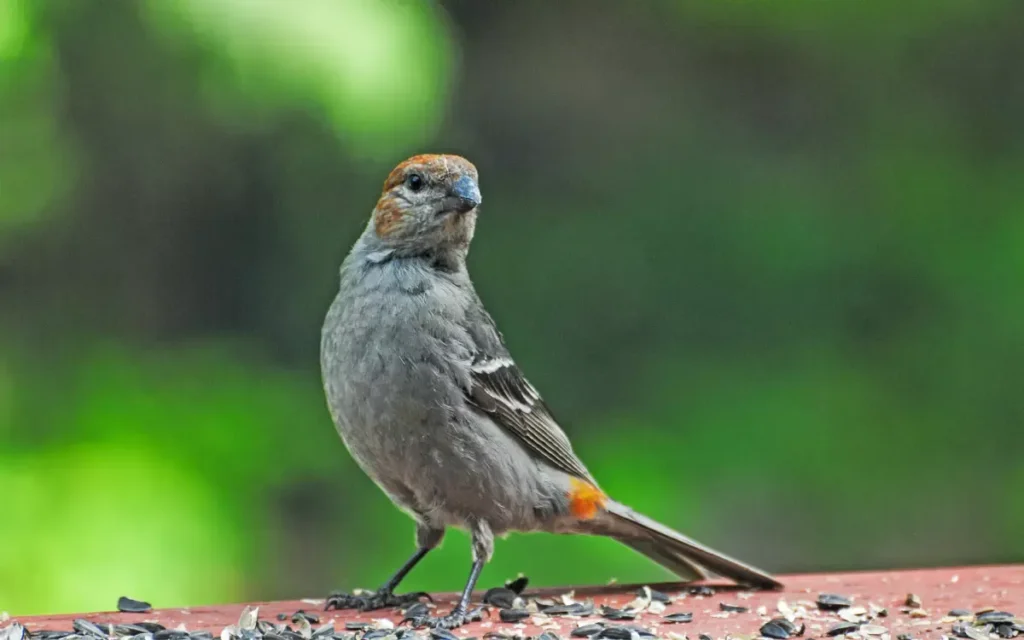
The Pine Grosbeak, a winter visitor to Wyoming, adds a touch of warmth to the snowy landscape with its vibrant red plumage.
These hardy birds are known for their affinity for pine seeds, which contribute to their colorful appearance. Their nests, hidden among coniferous trees, hold 3-4 eggs per brood.
- Length: 7.9-9.8 in (20-25 cm)
- Weight: 1.97 oz (56 gm)
- Wingspan: 13.0 in (33 cm)
- Lifespan: 9 years, 9 months
CALL:-
4. Purple Finch (Haemorhous purpureus)
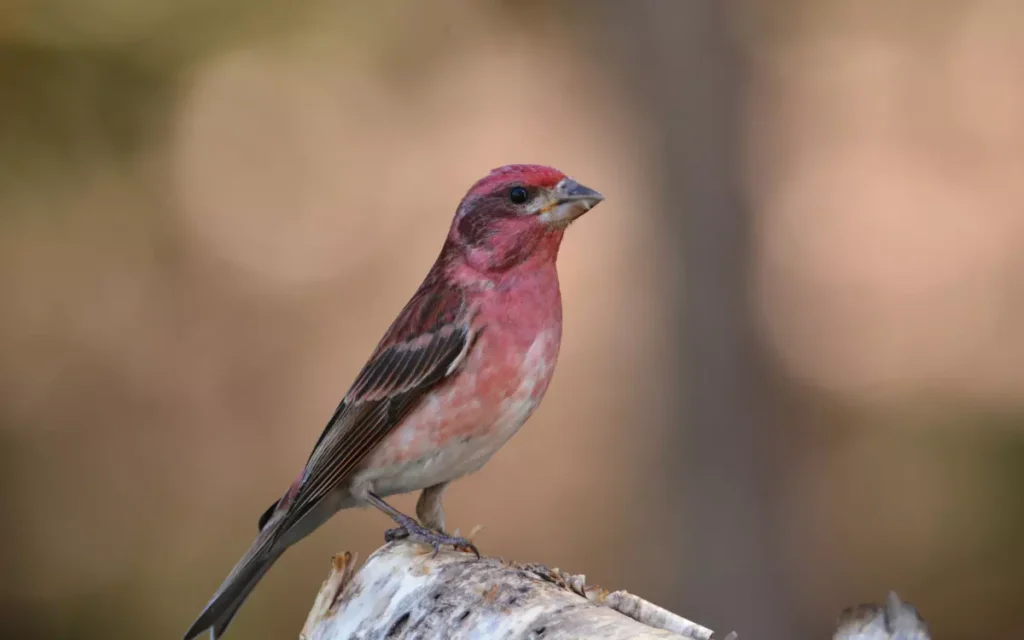
As the name suggests, the Purple Finch showcases a mix of red and purple hues in its feathers. Their enchanting songs are often heard echoing through Wyoming’s woodlands.
Purple Finches feed on seeds, fruits, and insects, resulting in their distinctive coloring. Their nests, usually built in shrubs or trees, contain 2-5 eggs.
- Length: 4.7-6.3 in (12-16 cm)
- Weight: 0.6-1.1 oz (18-32 g)
- Wingspan: 8.7-10.2 in (22-26 cm)
- Lifespan: up to 14 years
CALL:-
5. Northern Cardinal (Cardinalis cardinalis)
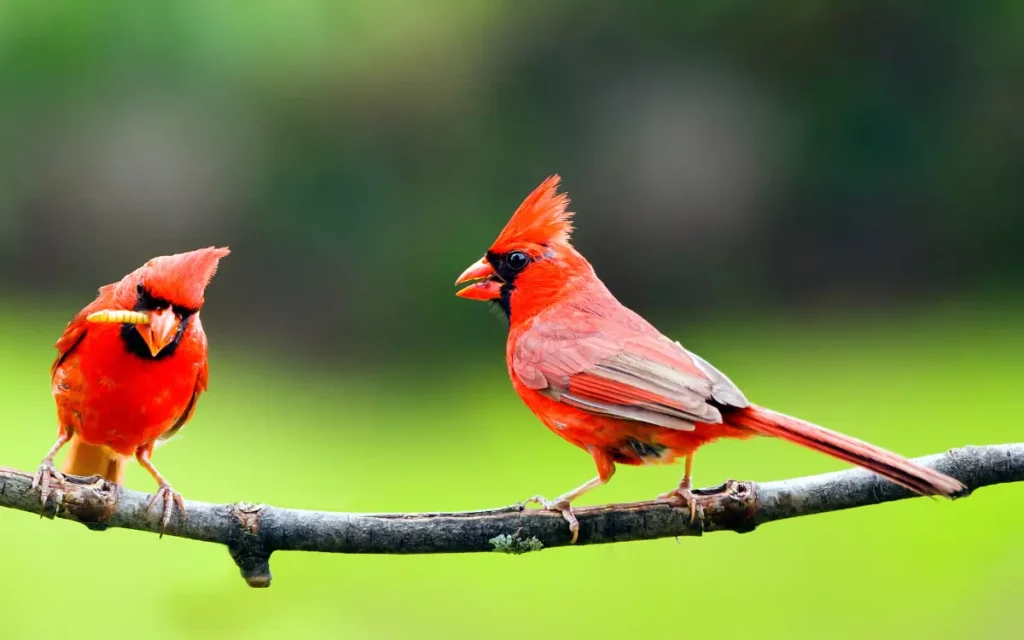
The Northern Cardinal is a true emblem of beauty with its bright red plumage and distinct crest. Despite its name, the Northern Cardinal is not native to Wyoming but has been introduced to the region.
These birds are known for their sweet and melodious songs that fill the air throughout the year. They typically lay 2-4 eggs in cup-shaped nests woven with grass and twigs.
- Length: 8.3-9.1 in (21-23 cm)
- Weight: 1.5-1.7 oz (42-48 g)
- Wingspan: 9.8-12.2 in (25-31 cm
- Lifespan: 15 years and 9 months
CALL:-
You may read also:-
6.Hepatic Tanager (Piranga flava)
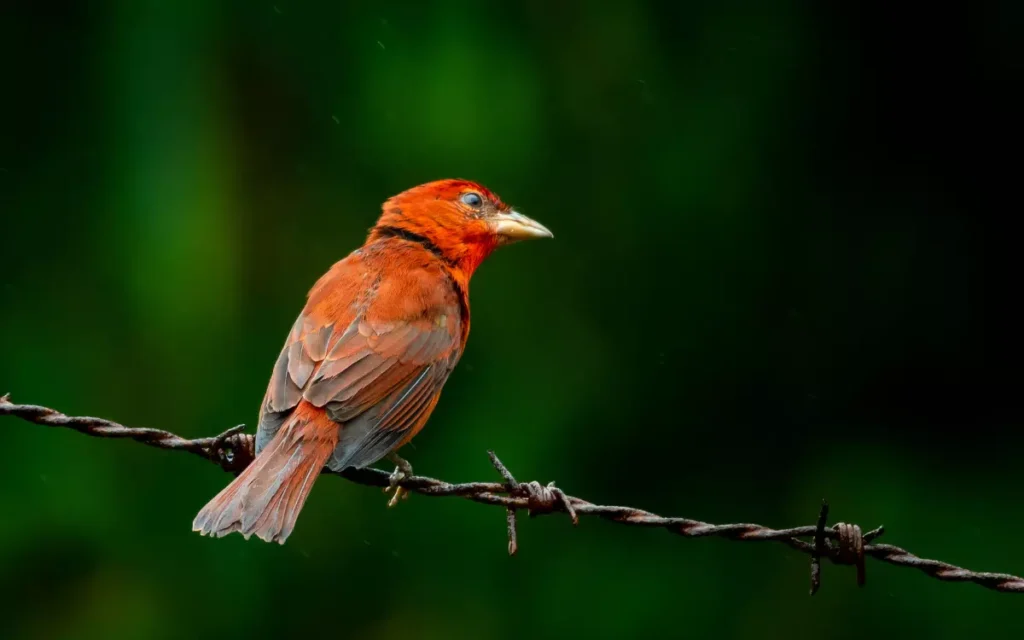
The Hepatic Tanager, often found in Wyoming’s wooded areas, flaunts a mix of red and orange hues that blend harmoniously with the natural surroundings.
Their coloring comes from their consumption of insects and berries rich in carotenoids. These birds build nests in trees, carefully laying 2-5 eggs per clutch.
- Length: 3.5-7.9 in (8.8-20 cm)
- Weight: 0.8-1.7 oz (23-47 g)
- Wingspan: 12.6 in (32 cm)
- Lifespan: 5 years
CALL:-
Orange Birds of Wyoming:
1.Scarlet Tanager (Piranga olivacea)
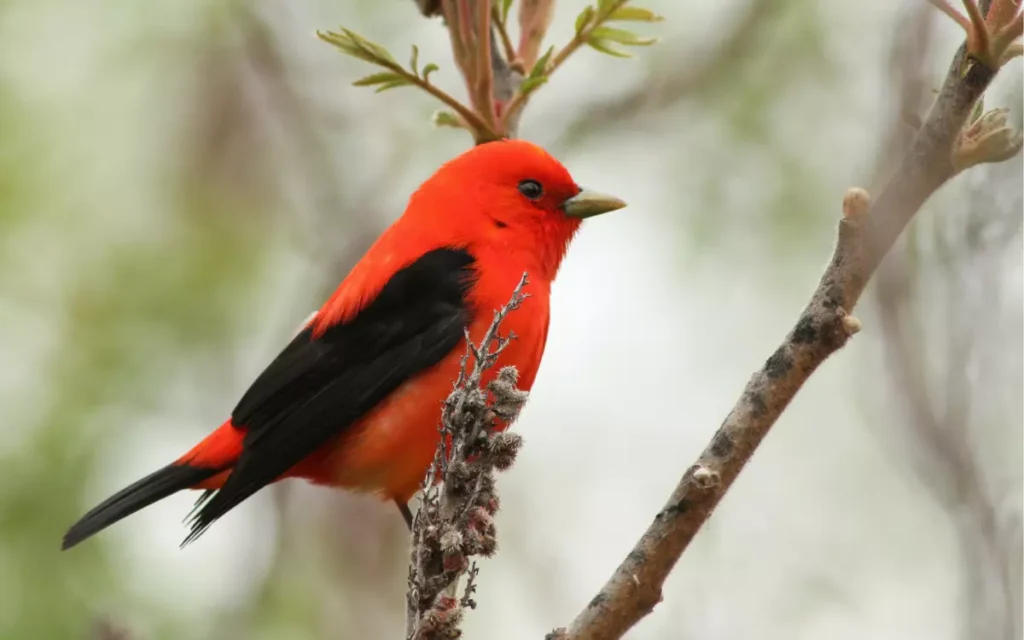
The Scarlet Tanager, with its fiery plumage and melodious songs, is a true gem among Wyoming’s avian residents. These birds are known for their vibrant orange-red plumage, making them stand out against the lush greenery of the state.
Scarlet Tanagers typically lay a clutch of three to five eggs in a well-concealed nest. These nests are often built in the canopy of deciduous trees, making them challenging to spot predators.
- Length: 6.3 to 7.5 in (16 to 19 cm )
- Weight: 0.83 – 1.34 oz (23.5 – 38 g )
- Wingspan: 9.8 – 11.8 in (25 – 30 cm )
- Lifespan: 11 years and 5 months
CALL:-
2. American Robin (Turdus migratorius)
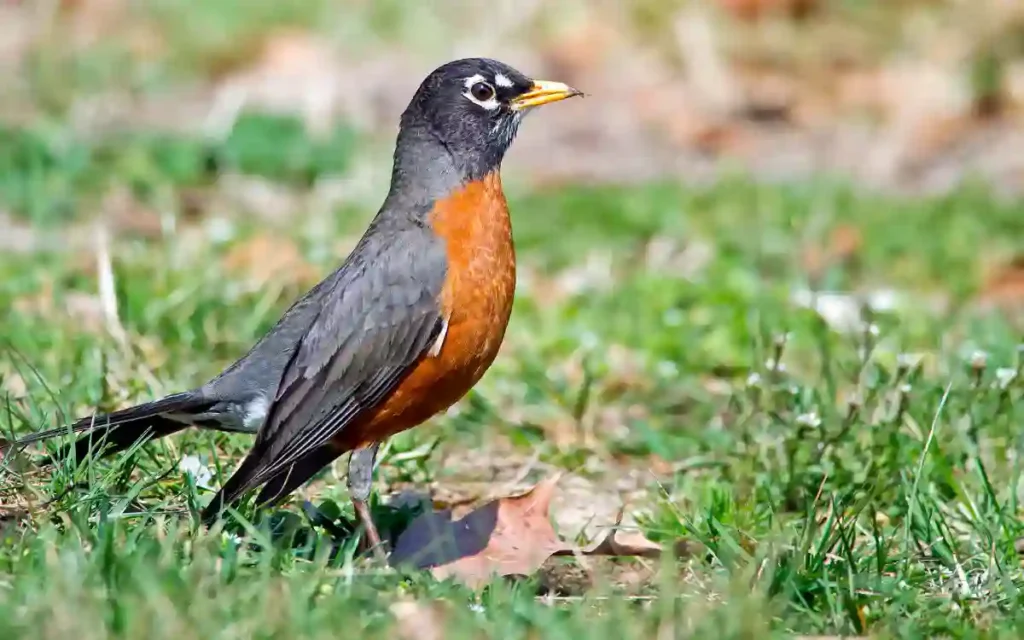
While the American Robin is widely recognized for its distinctive red-orange breast, it is also a common sight in Wyoming. These birds are known for their cheerful, melodious songs and are often associated with the arrival of spring.
American Robins usually lay a clutch of three to four eggs in a cup-shaped nest constructed with mud and lined with grass. Their nesting habits are fascinating, as they often build nests near human habitation.
- Length: 9.1 to 11.0 in (23 – 28 cm )
- Weight: 2.7-3.0 oz (77-85 g
- Wingspan: 12 to 16 in (31 – 41 cm)
- Lifespan: 14 years but the average lifespan is about 2 years.
CALL:-
3. American Redstart (Setophaga ruticilla)
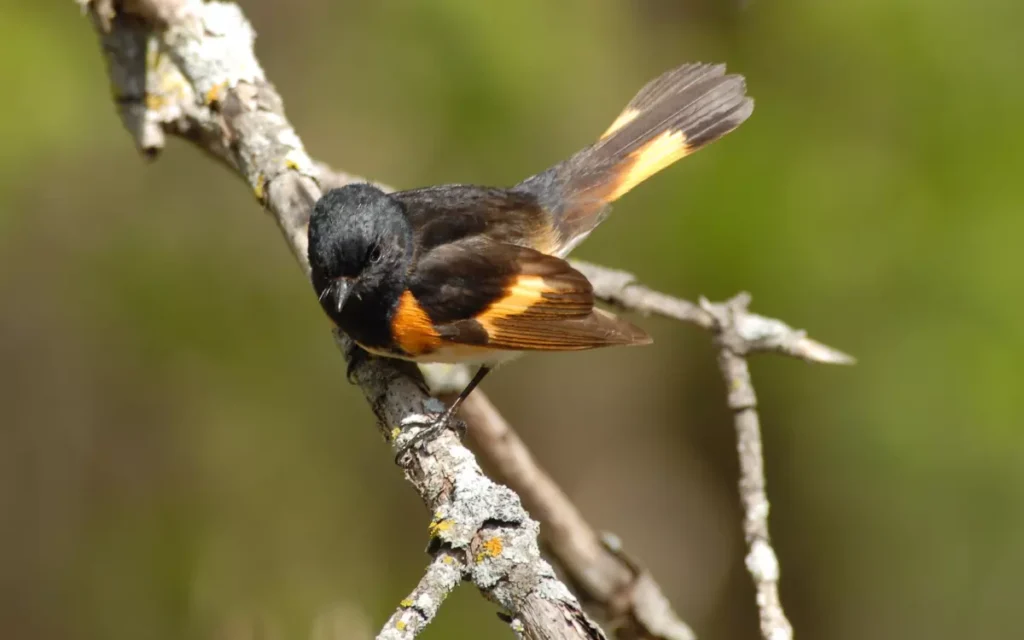
The American Redstart, with its vibrant orange patches on its wings and tail, is a captivating sight for birdwatchers. These small songbirds are known for their energetic foraging behavior.
American Redstarts typically lay between three to five eggs in nests placed in the understory of deciduous forests. The striking contrast between their black and orange plumage makes them easy to spot, even in dense foliage.
- Length: 4.3 – 5.5 in (11 to 14 cm)
- Weight: 0.21 – 0.31 oz (6 – 9 gm)
- Wingspan: 6.3 – 9.1 in (16 – 23 cm )
- Lifespan: around 5 years
CALL:-
4. Rufous Hummingbird (Selasphorus rufus)
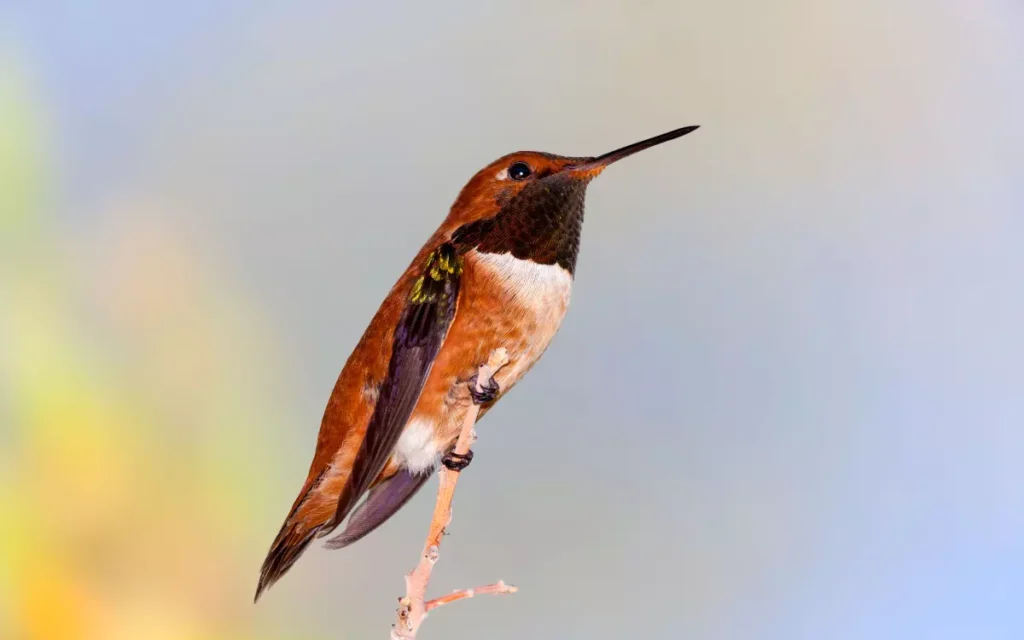
The Rufous Hummingbird is a tiny yet dazzling bird that graces Wyoming with its presence. These hummingbirds are famous for their vibrant orange-red plumage and remarkable aerial acrobatics.
Rufous Hummingbirds lay two tiny eggs in nests constructed from moss and spider silk, often camouflaged on tree branches. Their ability to hover in mid-air while feeding on nectar is a wonder to behold.
- Length: 3.1 in (8 cm )
- Weight: 0.1 – 0.14 oz (3 – 4 gm)
- Wingspan: 3.74 in (9.5 cm)
- Lifespan: 3 -4 years
CALL:-
5. Black-Headed Grosbeak (Pheucticus melanocephalus)
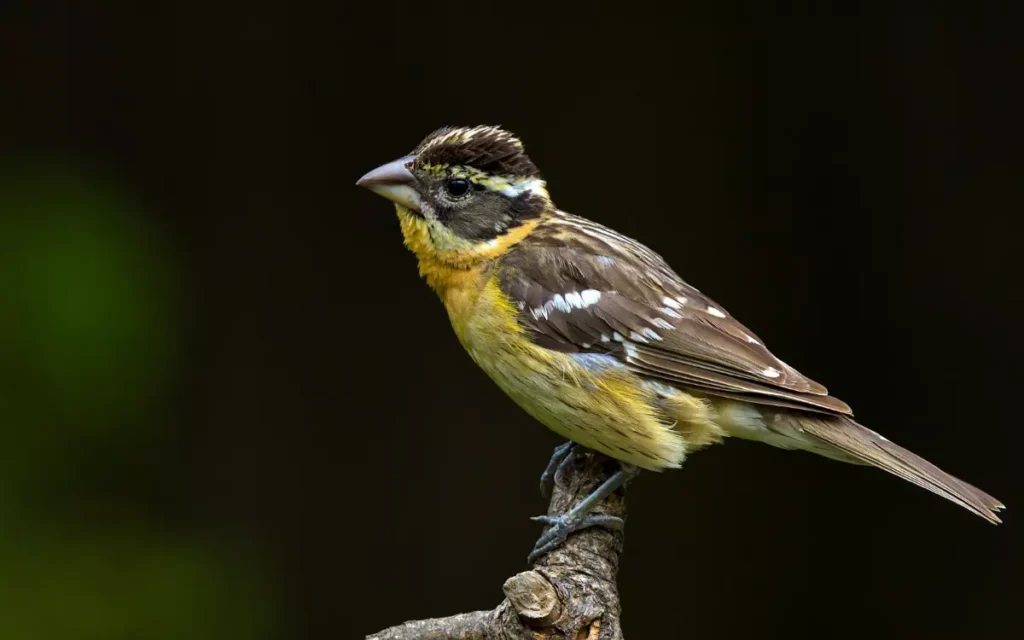
Black-Headed Grosbeaks are striking birds with bold black and vibrant orange plumage. Their distinctive songs echo through Wyoming’s woodlands during the breeding season.
These grosbeaks typically lay two to five eggs in well-hidden nests, often tucked away in shrubs or trees. The contrast between their dark heads and bright orange bodies is a sight to behold.
- Length: 7.1–7.5 in (18–19 cm)
- Weight: 1.2–1.7 oz (34–48 g)
- Wingspan: 12.6 in (32 cm)
- Lifespan: 11 years, 11 months old
CALL:-
6. American Kestrel (Falco sparverius)
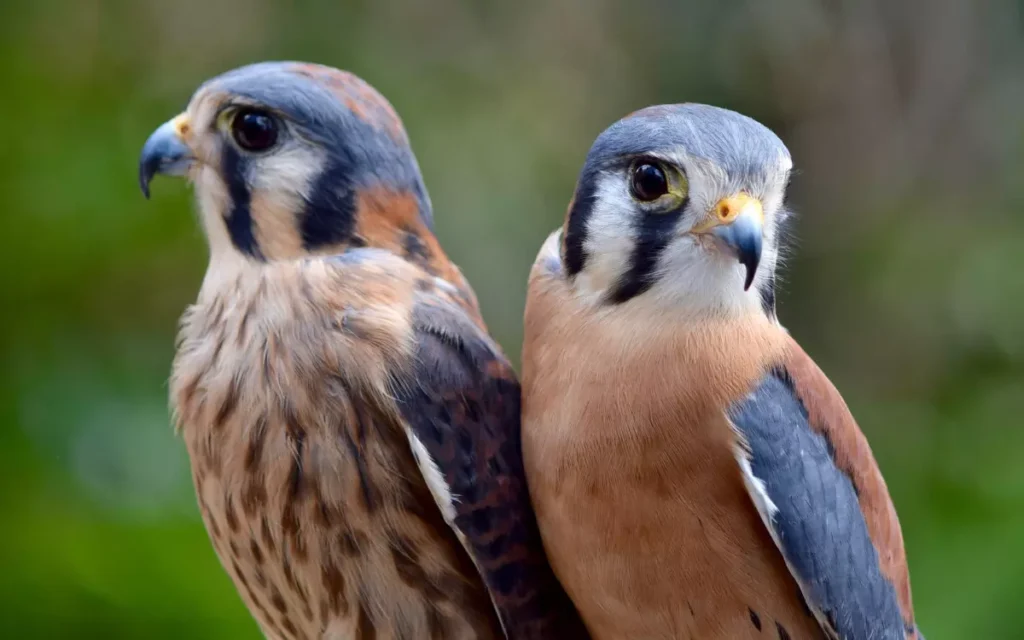
The American Kestrel, a small but mighty falcon, exhibits a striking mix of orange, blue, and gray feathers. These birds of prey are known for their exceptional hunting skills.
American Kestrels usually lay a clutch of three to seven eggs in tree cavities or abandoned nests. Their keen eyesight and agile flight make them formidable hunters in Wyoming’s open landscapes.
- Length: 8.7 – 12.2 in ( 22 – 31 cm)
- Weight: 2.8-5.8 oz (80-165 g)
- Wingspan: 20–24 in (51–61 cm)
- Lifespan: 14–17 years
CALL:-
7. Red Crossbill (Loxia curvirostra)
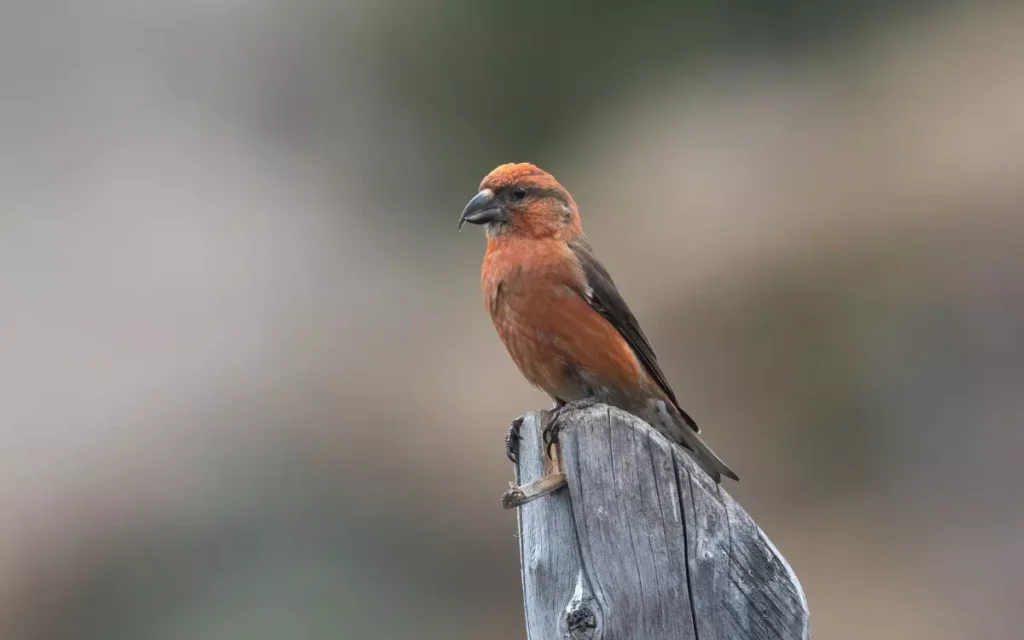
The Red Crossbill is a unique bird, known for its crossed bill tips that aid in extracting seeds from conifer cones. While not entirely orange, their plumage exhibits shades of red and orange, adding to their distinctiveness.
Red Crossbills typically lay two to five eggs in nests constructed on conifer branches. Their specialized bill adaptation sets them apart as remarkable foragers.
- Length: 7.87 in (20 cm)
- Weight: 1.41 – 1.86 oz ( 40-53 gm)
- Wingspan: 10.62 – 11.41 in (27–29 cm)
- Lifespan: 8-10 years
CALL:-
Description of the Significant 12 Yellow Birds in Wyoming:
1. American Yellow Warbler (Setophaga petechia)
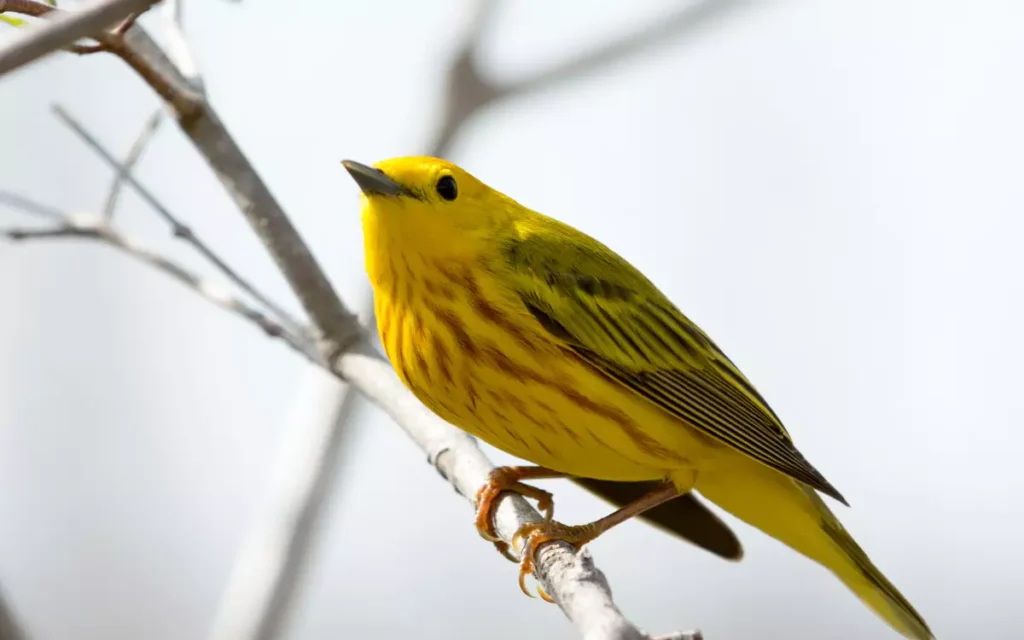
With its vibrant yellow plumage and sweet, melodious song, the American Yellow Warbler is a charming inhabitant of Wyoming’s lush forests and wetlands.
These small songbirds are known for their distinctive bright yellow color and often sport reddish streaks on their chests. They are skilled nest builders, crafting intricate nests from plant fibers and spider silk. American Yellow Warblers lay an average of 4 to 5 eggs per clutch.
- Length: 4.7 – 5.1 in (12 -13 cm)
- Weight: 0.3 – 0.4 oz (8 – 12 gm)
- Wingspan: 6.3 – 7.5 in (16 – 19 cm)
- Lifespan: 11 years.
CALL:-
2. Wilson’s Warbler (Cardellina pusilla)
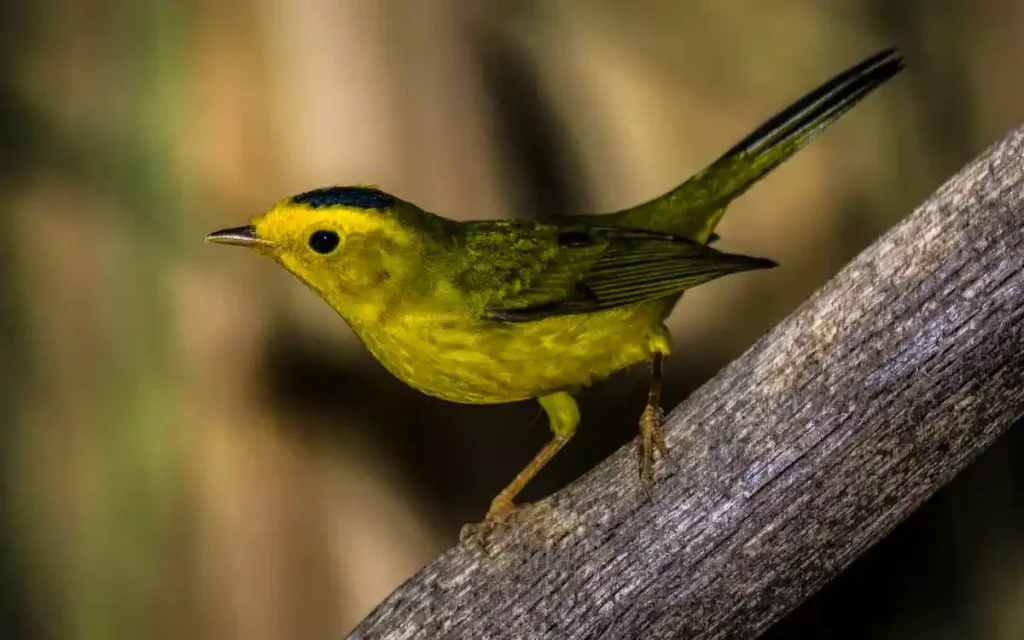
The Wilson’s Warbler is a delightful sight for birdwatchers in Wyoming. With its lemon-yellow plumage and striking black cap, this small songbird is hard to miss.
Found in shrubby habitats and forest edges, Wilson’s Warblers are known for their energetic foraging behavior. They often lay around 3 to 5 eggs in cup-shaped nests skillfully hidden within dense vegetation.
- Length: 3.9-4.7 in (10-12 cm)
- Weight: 0.2-0.3 oz (5-10 g)
- Wingspan: 5.5-6.7 in (14-17 cm)
- Lifespan: 2 to 5 years
CALL:-
3. Scott’s Oriole (Icterus parisorum)
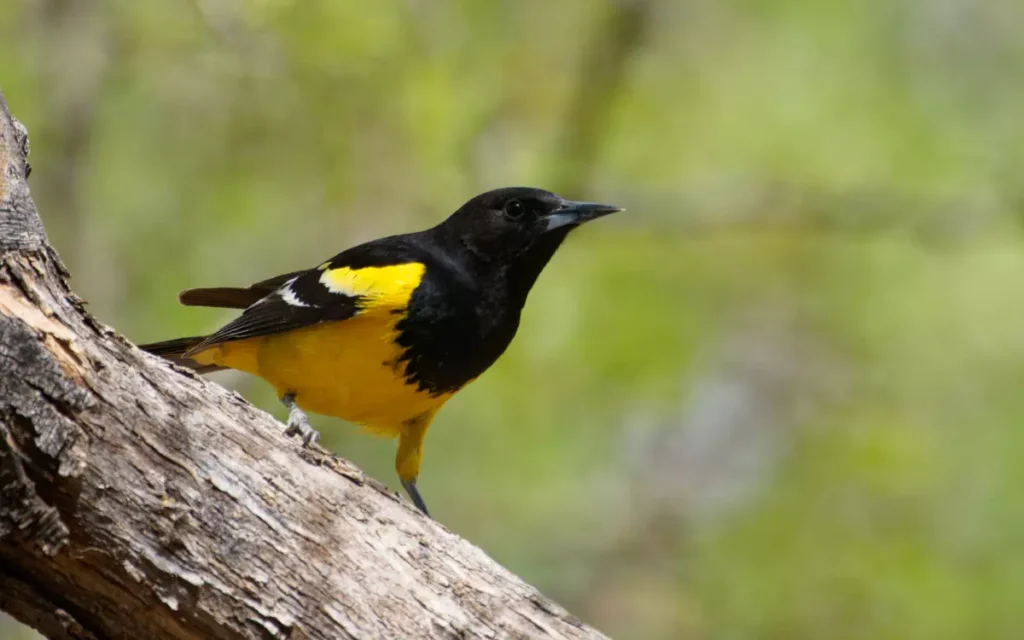
Scott’s Oriole graces the southwestern parts of Wyoming with its brilliant yellow and black plumage. These skilled acrobats are often seen hanging from the tips of branches, searching for insects and nectar.
Scott’s Orioles are known for their intricate woven nests suspended from the ends of high branches. The female lays about 3 to 5 eggs, carefully tending to them until they hatch.
- Length: 9.1 in (23 cm)
- Weight: 1.1-1.4 oz (32-41 g)
- Wingspan: 12.6 in (32 cm)
- Lifespan: 5 to 8 years
CALL:-
4.Western Tanager (Piranga ludoviciana)
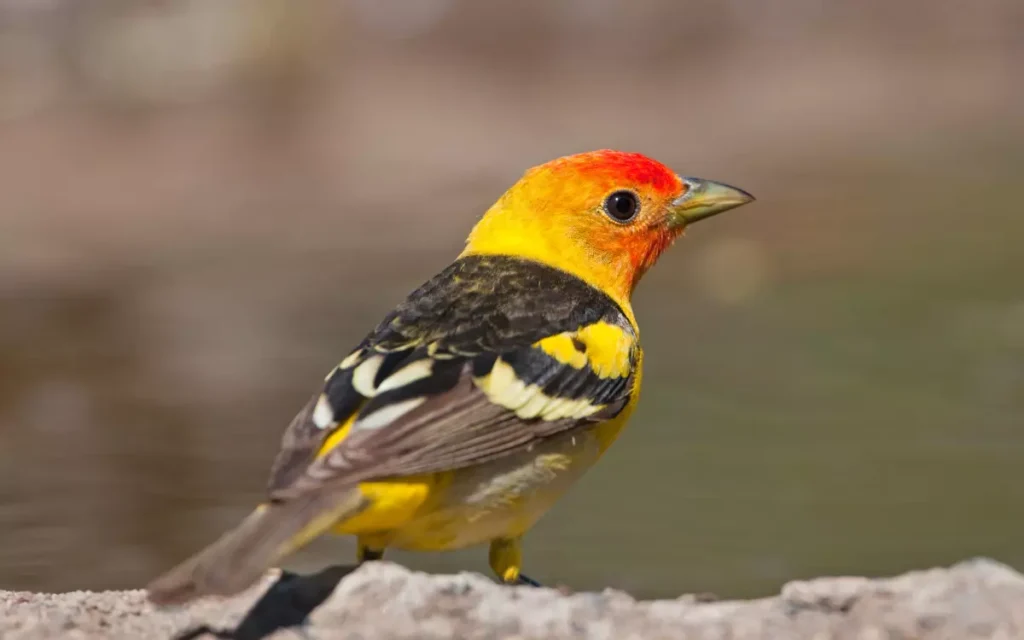
The Western Tanager is a striking bird with a mix of bright yellow plumage and black wings.
It’s a summer visitor to Wyoming’s forests, where it feeds on insects and fruits. Their cup-shaped nests are often built high in coniferous trees, providing safety for the 3 to 5 eggs laid by the female.
- Length: 6.3-7.5 in (16-19 cm)
- Weight: 0.8-1.3 oz (24-36 g)
- Wingspan: 11.02 – 11.81 in(28 – 30 cm)
- Lifespan: 6 – 8 years
CALL:-
5. American Goldfinch (Spinus tristis)
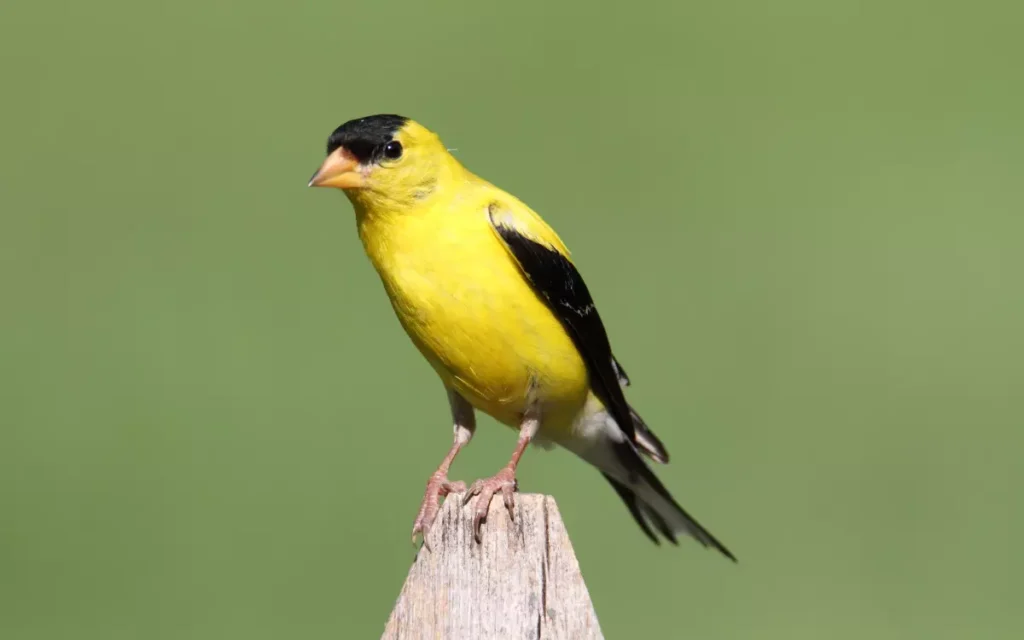
The American Goldfinch is a year-round resident of Wyoming, adding a splash of yellow to gardens and open areas. These small finches undergo a molt in late summer, transitioning from a bright breeding plumage to a duller winter appearance.
American Goldfinches are known to lay 4 to 6 eggs in their well-crafted nests.
- Length: 4.3-5.1 in (11-13 cm)
- Weight: 0.4-0.7 oz (11-20 g)
- Wingspan: 7.5-8.7 in (19-22 cm)
- Lifespan: 3 to 6 years
CALL:-
6. Evening Grosbeak (Hesperiphona vespertina)
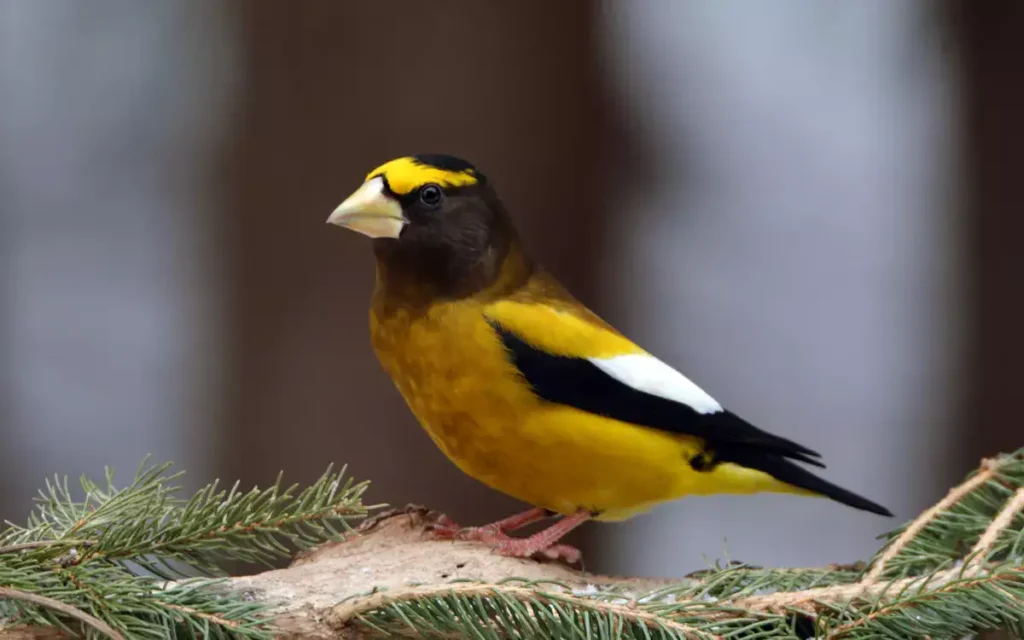
The Evening Grosbeak is a unique addition to Wyoming’s bird population. With its chunky build and vibrant yellow patches on its wings and body, this bird is a true gem.
Evening Grosbeaks often gather in noisy flocks, foraging for seeds and fruits. Their cup-shaped nests contain 2 to 4 eggs, which are incubated by the female.
- Length: 16 to 22 cm (6.3 to 8.7 in)
- Weight: 38.7 to 86.1 g (1.37 to 3.04 oz)
- Wingspan: 30 to 36 cm (12 to 14 in)
- Lifespan: 5 to 10 years
CALL:-
7. Bullock’s Oriole (Icterus bullockii)
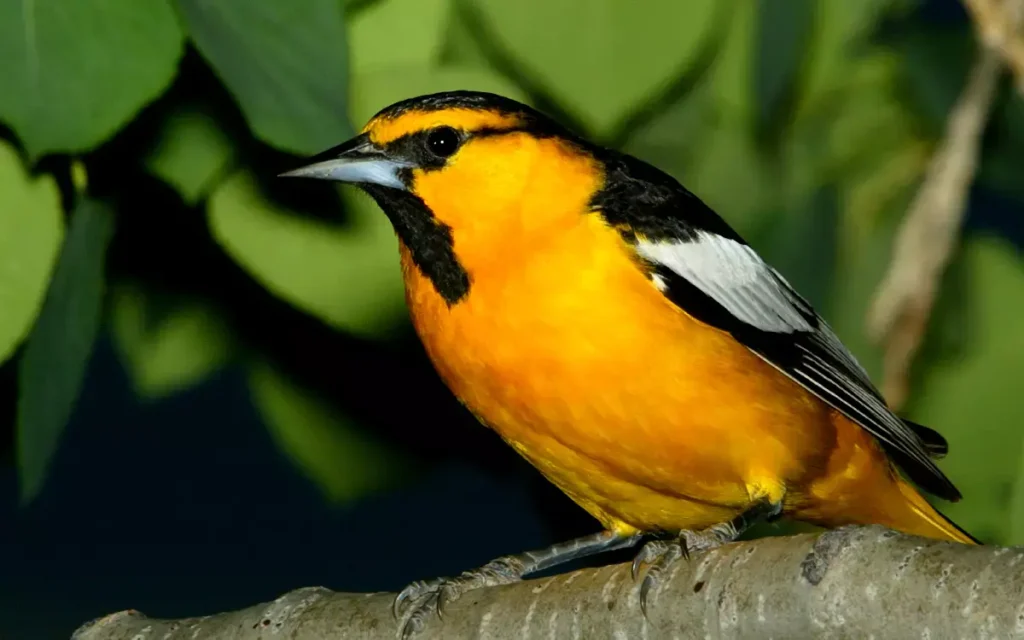
Bullock’s Oriole brings a touch of elegance to Wyoming’s landscapes with its contrasting black and yellow plumage.
These orioles are known for their intricate pendulous nests hanging from the tips of branches. Their nests typically hold 3 to 5 eggs, and the young are cared for by both parents.
- Length: 6.7–7.5 in (17–19 cm)
- Weight: 1.0–1.5 oz (28–43 g)
- Wingspan: 12.2 in (31 cm)
- Lifespan: 6 to 8 years
CALL:-
8. Yellow-breasted Chat (Icteria virens)
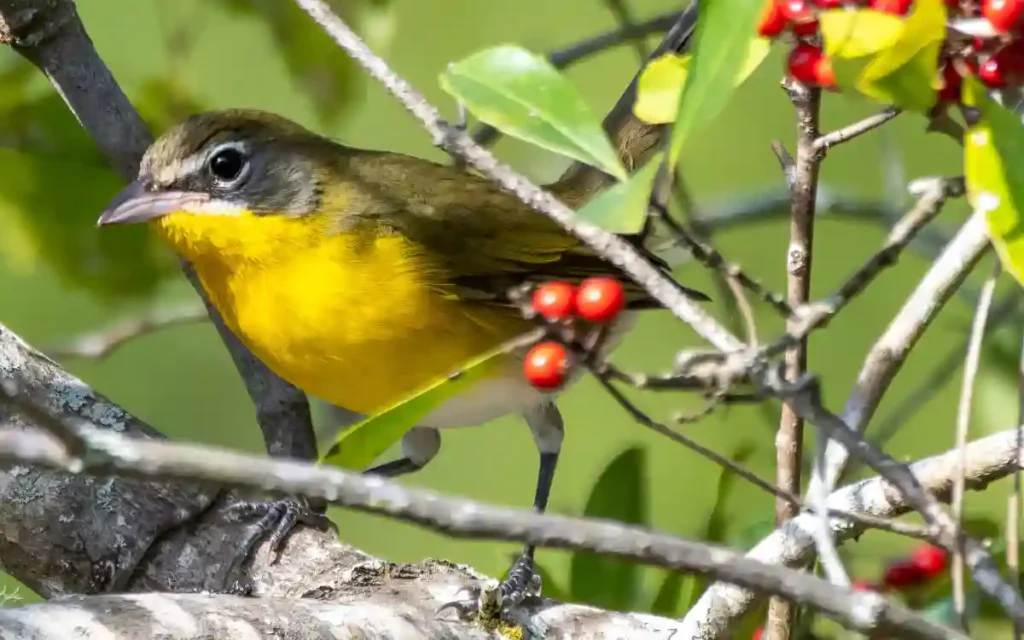
Yellow-breasted Chats are known for their vibrant yellow throats and unique song repertoire. Despite their name, they are more closely related to warblers than true chats.
These secretive birds are often found in dense thickets and shrubs, where they lay around 3 to 5 eggs in well-hidden nests.
- Length: 6.7 – 7.5 in (17 -19.1 cm)
- Weight: 0.71 to 1.19 oz ( 20.2 – 33.8 gm)
- Wingspan: 9.1 – 10.6 in (23 – 27 cm)
- Lifespan: 3 to 6 years
CALL:-
9. New World Warblers (Parulidae)
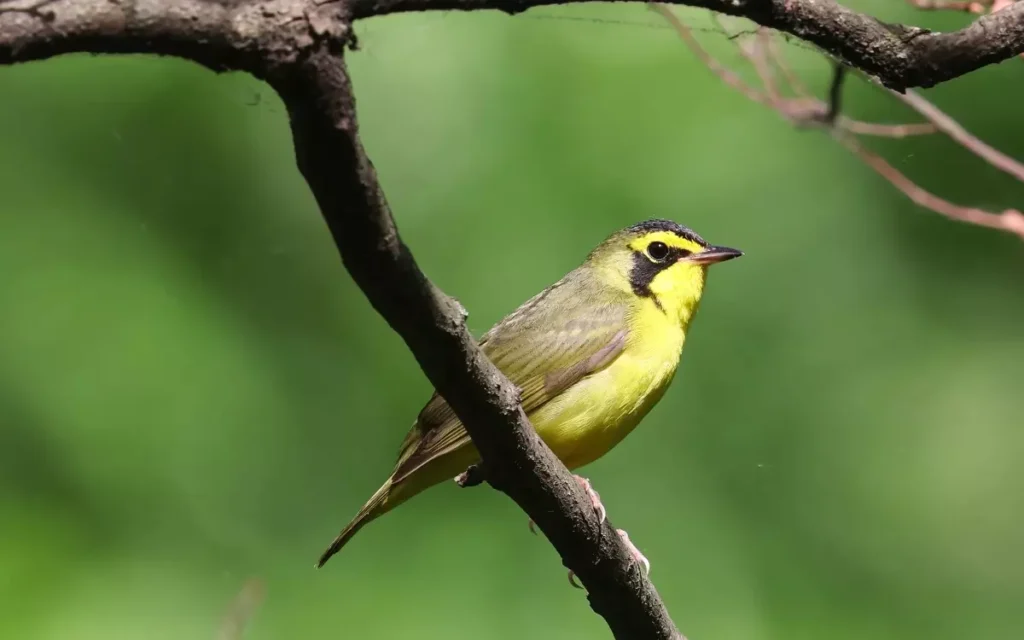
Wyoming is home to several species of New World Warblers, each showcasing varying shades of yellow in their plumage.
These agile insectivores often migrate through the state during their annual journeys. Their nesting habits vary, with some warblers laying 4 to 5 eggs in open cup-shaped nests.
- Length: 4.2 in (10.6 cm )
- Weight: 0.23 oz (6.5 gm)
- Wingspan: 5 – 10 in(13 – 25 cm)
- Lifespan: 2 – 5 years
CALL:-
10. MacGillivray’s Warbler (Geothlypis tolmiei)
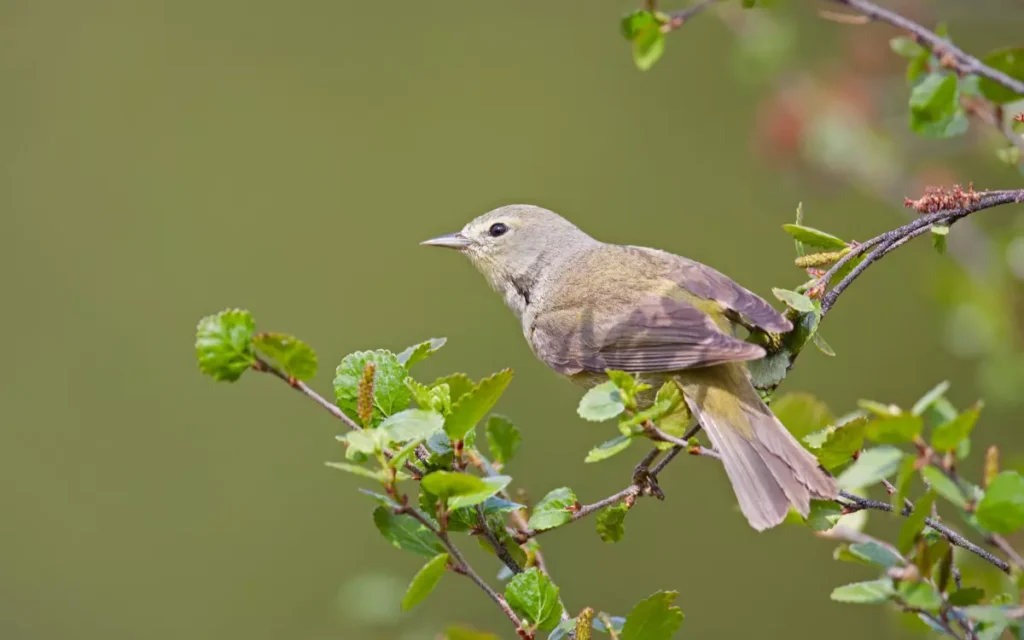
MacGillivray’s Warbler is a warbler species that inhabits shrubby areas and forests across Wyoming. With its olive-green back and striking yellow underparts, this warbler is a sight to behold. These birds tend to lay around 3 to 5 eggs in their well-concealed nests, often built close to the ground.
- Length: 3.9–5.9 in (9.9–15.0 cm)
- Weight: 0.3–0.5 oz (8.5–14.2 gm)
- Wingspan: 7.5 in (19 cm)
- Lifespan: 2 to 5 years
CALL:-
11. Townsend’s Warbler (Setophaga townsendi)
The Townsend’s Warbler is a migratory songbird that graces Wyoming’s forests with its vibrant yellow plumage and distinctive black markings.
These warblers are known for their affinity for coniferous habitats. Townsend’s Warblers usually lay around 3 to 5 eggs in their nests, located in dense shrubs and trees.
- Length: 4.7-5.0 in (12-12.7 cm)
- Weight: 0.3-0.4 oz (7.3-10.4 g)
- Wingspan: 7.5-8.3 in (19-21 cm)
- Lifespan: 2 to 6 years
CALL:-
12. Yellow-headed Blackbird (Xanthocephalus xanthocephalus)
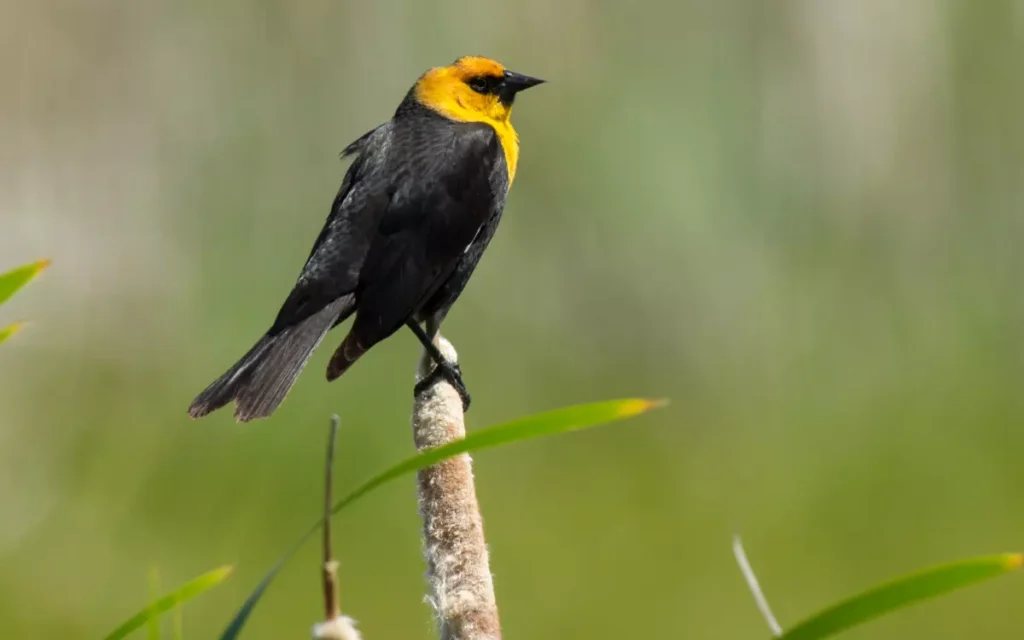
Yellow-headed Blackbirds are a striking presence in Wyoming’s wetlands and marshes. As their name suggests, these birds sport bright yellow heads contrasted by black bodies.
Their unique appearance and captivating calls make them stand out. Yellow-headed Blackbirds are known to lay 3 to 6 eggs in their well-concealed nests.
- Length: 8 -10 in (20 – 25 cm)
- Weight: 2.5 – 4.0 oz (70 -115 gm )
- Wingspan: 13.8 – 16.1 in (35 – 41 cm)
- Lifespan: 10-11.8 years
CALL:-
FAQ:
1.How do the colors of these birds serve a purpose beyond aesthetics?
The vibrant colors of red, orange, and yellow birds are not just visually appealing; they play a crucial role in their survival. These colors can serve as signals for mating rituals, territorial displays, and even warnings to potential predators. For instance, the vibrant plumage of a male Northern Cardinal isn’t just charming; it’s a way to attract a suitable mate.
2.What challenges arise when identifying birds based on their colors?
While colors provide valuable clues, they can also pose challenges. Lighting conditions, age-related changes, and even genetic variations can lead to differences in coloration. Moreover, some bird species exhibit sexual dimorphism, where males and females have different colors. This makes accurate identification a nuanced task that demands a keen eye and a deep understanding of avian biology.
3. Are there any bird species that are exclusively red, orange, or yellow?
Yes, Wyoming is home to some bird species that are predominantly red, orange, or yellow. The Western Tanager, for instance, is a delightful bird with a bright yellow body and a fiery orange head. The Western Meadowlark, the state bird of Wyoming, features a striking yellow plumage with black markings. These birds showcase the stunning diversity within these color categories.
4. How can bird enthusiasts contribute to bird conservation in Wyoming?
Bird enthusiasts can play a vital role in preserving Wyoming’s avian treasures. By participating in citizen science initiatives, such as bird counts and habitat monitoring, individuals can contribute valuable data that aids in understanding bird populations and their trends.
Supporting local conservation organizations and promoting responsible birdwatching practices also make a meaningful impact.
5. Are there any online resources for learning more about Wyoming’s bird species?
Absolutely! Several reputable websites and organizations offer comprehensive resources for bird enthusiasts. The Cornell Lab of Ornithology’s website provides a wealth of information on bird identification, behavior, and conservation.
The Wyoming Birding Trail website offers maps, birding tips, and locations to explore Wyoming’s diverse birdlife.
6. What is the best time of year for birdwatching in Wyoming?
Wyoming’s birdwatching seasons vary depending on the species and their migratory patterns. Spring and fall are often considered prime birdwatching seasons as many species migrate through or stopover in Wyoming.
The lush landscapes of spring and the vibrant foliage of fall create picturesque settings for observing these colorful feathered travellers.
Conclusion:
Embarking on a journey to explore the red, orange, and yellow birds of Wyoming is to witness nature’s canvas unfold before our eyes. From the enchanting melodies of songbirds to the graceful flights of raptors, each moment spent in the company of these vibrant birds is a testament to the wonder and beauty of the natural world.
By understanding their colors, behaviors, and significance, we not only deepen our connection to the avian realm but also contribute to its conservation for generations to come.

